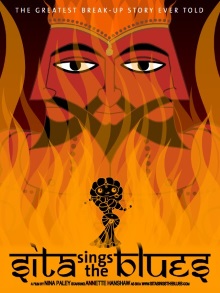
Sita Sings the Blues is as indie a film as you can imagine, being made largely by a single person, Nina Paley, with crowdfunded money. Apparently she created almost the entire thing on her own home computer with popular commercial software like Adobe Flash. The film also makes heavy use of jazz songs by Annette Hanshaw from the 1920s. This caused copyright problems which made it difficult for this film to be distributed normally. That’s why the creator has encouraged fans to freely distribute it in any way they like including using BitTorrent.
The wonder of it is not only is this startlingly original, it is also rather good. Story-wise, there are two parallel tracks. The first is the deeply personal story of the marriage of the auteur herself who finds her husband drifting away from her after he accepts a job in India. The second is a very abbreviated interpretation of the epic Sanskrit poem the Ramayana from the perspective of the character of Sita. While in exile together with Ram in the forest, Sita is abducted by the demon king Ravana. With the aid of the monkey prince Hanuman, Rama succeeds in rescuing her but begins to doubt her purity as she has lived under the roof of another man, as he puts it.
It’s called singing the blues because this is what most of the screen-time is devoted to as Sita wonders what she has done wrong such that Rama abandons her and pines for him. To be honest, there’s so much of it that it started to grate on me, especially since all of the songs in the latter half of the film share the same themes and don’t add anything new to the story. Still, the songs match the wonderfully creative animations and the story so perfectly that my wife was shocked that the performances weren’t recorded specifically for this project.
Between the singing parts, there are story sequences, often narrated by a trio of Indians. They’re represented visually as shadow puppets. Apparently this narration was not scripted in advance and were based on the personal knowledge of the narrators. The casual, sometimes irreverent, manner that they use to recount the story helps to convey the sense that there are many different versions of the Ramayana and like all myths don’t always make much sense by modern standards. It’s not a replacement for real study of the poem of course, but reading up on it, it can be quite surprising how much detail Paley managed to work in, including Hanuman’s burning tail and how he used it to set buildings in Lanka on fire.
One thing that can get confusing is that the film uses many different animation styles. When Sita sings for example, the characters look so different from the way they are normally depicted that we at first doubted that they are supposed to be the same people. Yet despite the primitive technology used, the sheer creativity of the art never fails to surprise, charm and delight the audience. It’s also powerfully emotive as the project is very obviously an effort by Paley to work through her own anguish due to the failure of her marriage. It is actually quite shocking how much Paley has opened her heart to the public through this film.
The film attracted a great deal of ire from conservative Hindus who perceive it as an insult against the values espoused in the Ramayana and Indian culture. I say that this is exactly what good art should strive to do and considering India’s poor record of treating their women with respect, critiquing Indian culture on these grounds seems entirely warranted. Less predictably, Paley has also been criticized by academics as yet another white person offering an interpretation on a culture that isn’t hers. To this, I think that the Ramayana is so unknown in the West that any portrayal of it should be seen as being welcome regardless of the source.
I’d still have preferred more story and less wistful pining. It’s not like there is any lack of additional anecdotes in the source material. But, as it is, Sita Sings the Blues is an amazing gem of a film that is all the more miraculous considering how much it achieves with so little.
One thought on “Sita Sings the Blues (2008)”